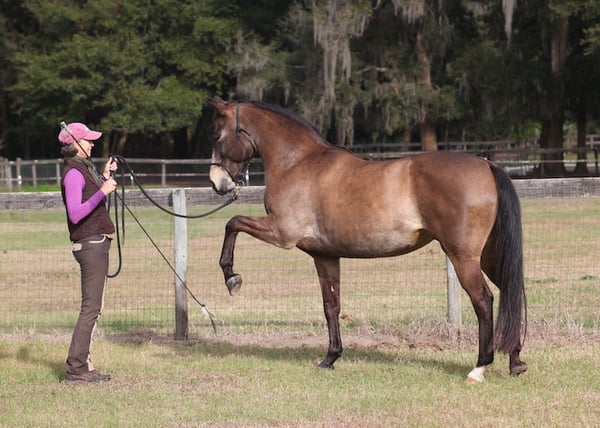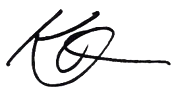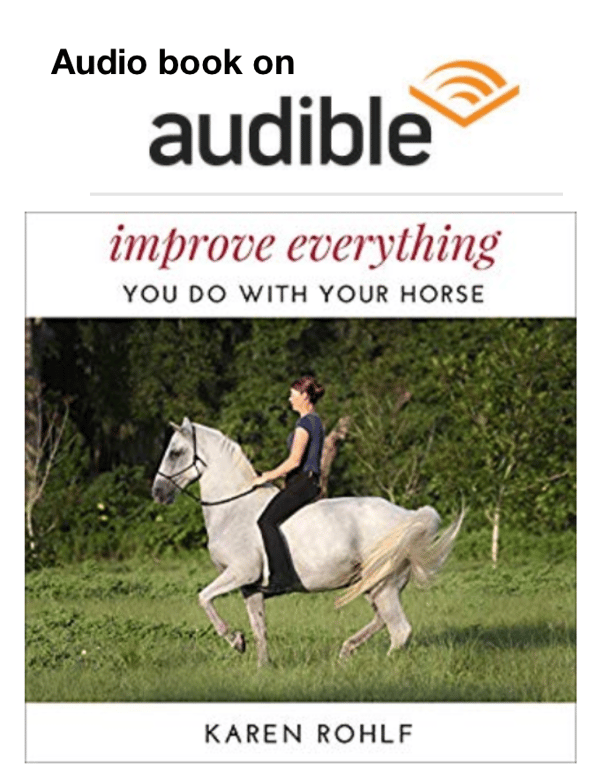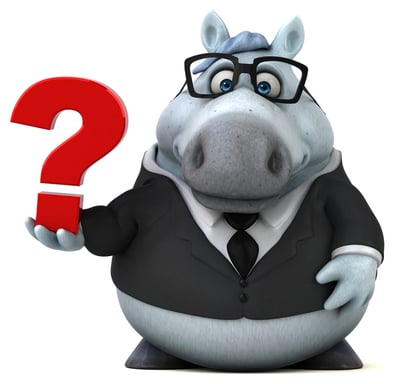
The key to getting the benefit out of a specific dressage exercise or movement is to know WHY you are doing it. If you don't know what the point of the exercise is, you won’t know what to feel for or when you have done it successfully.
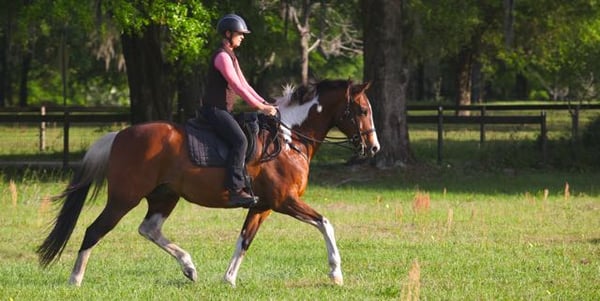
Training for quality of movement can be challenging to do by yourself. The question 'is this good enough?' can play like a broken record in our minds, causing us to repeat exercises over and over again. It's easy to think that if we do something just one more time, maybe we'll suddenly know beyond a shadow of a doubt that we got it... But we may be focusing on the things that aren't working and not noticing the things that are!
3 Problems that can arise when you don't know the purpose of the exercise:
- Inadvertently correcting the horse for doing something you should be encouraging
- Working too hard on the criteria, but missing the essence of the movement
- Missing long-term advantages, risking burnout
When you really know what you are feeling for, you will be able to feel the smaller but very real drops of progress that make the difference between developing your horse and just moving around a lot.
Lack of clarity about what the real point of an exercise is can cause riders to miss some really golden training moments. Before we achieve the whole perfect picture, we will have to settle for parts and pieces. The trick is to know which parts are the important parts!
Example:
Corrections that will make things worse -
I have a favorite dressage exercise for creating more powerful trot lengthenings/extensions in lower-energy horses. It is a pattern that builds a horse's motivation to put in more effort and really 'go for it' across the diagonals.
Often, when doing the exercise, a horse may break into the canter. If the rider thought the exercise was to build a perfectly balanced trot lengthening, she may correct the horse when she feels him start to become unbalanced or change gait... That could end up causing the horse to feel criticized for trying to put in more effort, and make him more careful and reserved in the next attempt ... That's the opposite of the point of this exercise!
When doing this exercise, I make sure the student knows the goal is to motivate the horse to put in more effort and have better impulsion, so we want to praise increased effort no matter how it shows up! Once the horse is willing to really 'go for it' on the diagonal, then we have something we can work with and can go back to balancing, regulating, and perfecting it.
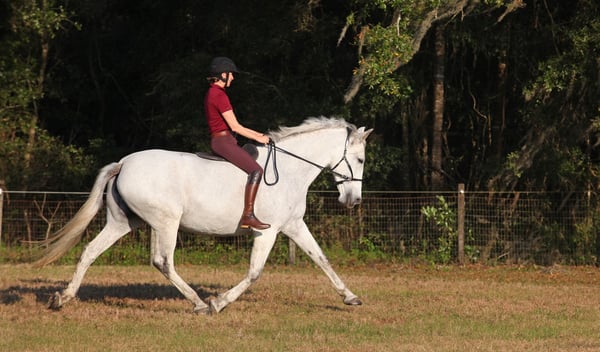 (Photo: Karen Rohlf and Natilla bareback and bitless)
(Photo: Karen Rohlf and Natilla bareback and bitless)
Example:
Missing the point -
The point of shoulder-in is not just to see if you can get your horse into that position to make the judge happy.
The purpose of shoulder-in is to:
- Create more engagement on the inside hind
- Reinforce the bend
- Lighten and free the shoulders.
You can put your horse's body in the shape of shoulder-in, meet the criteria for what a shoulder-in should look like, do it for miles, and never get the same benefit as doing only a few strides of a shoulder in where you are actively feeling for those very specific qualities above.
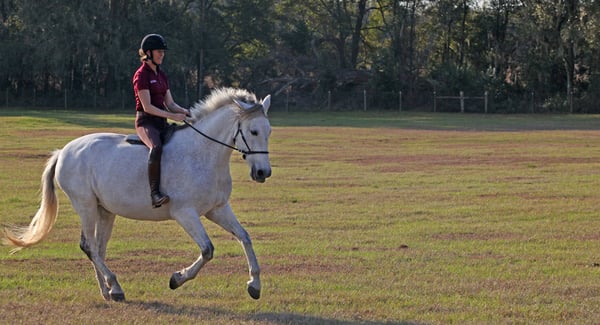 (Photo: Karen Rohlf and Natilla bareback and bitless)
(Photo: Karen Rohlf and Natilla bareback and bitless)
Criteria versus Essence
Every movement or dressage exercise has its Criteria and its Essence. The criteria is what makes it recognizable. It is the roadmap of the exercise or the description of where the body parts should be. If enough of the criteria are there, an observer can say, 'Hey, that person is doing a ______'. For example the criteria of a Simple Change is: Canter, walk a few strides, Canter on the other lead.
The Essence of the movement speaks to the purpose or the quality of it. The essence of a Simple Change is the balance, engagement, and clarity of the gaits in the transitions. When the essence is of high quality, even an uneducated person may say: 'I don't know what they are doing but it sure is beautiful!' 😎
Essence and Criteria work together, and in the best case they help each other. In real life moments, if you can't have both, you may have to prioritize one over the other. In competition, you often have to choose getting the Criteria done even if you lose some quality. In training, however, it is sometimes preferable to allow some wiggle room on the Criteria in order to get the Essence.
None of this will make sense unless you take the time to know what the Criteria and Essence are for any exercise you are doing!
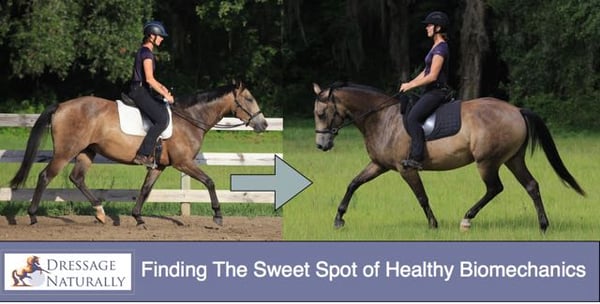
Where Do You Learn About Criteria and Essence?
Hopefully you find a teacher who will explain movements and exercises in terms of what is supposed to be accomplished as well as why and how. Ask questions if you are unsure. The dressage test score sheets also give you a lot of information in the Directives column about the qualities the judge is looking for. The dressage rule book is full of good information.
Long Term Benefits
You want to be aware of the long-term goals and benefits of specific categories of exercises. Flexibility exercises (involving changes of bend and direction) will create suppleness. Collectibility exercises (involving transitions) will create greater carrying power and engagement. Mobility exercises (lateral work) will create straightness. This is true ONLY if you realize that this is what they are meant to create!
Gymnastic development done well will help your horse feel more powerful, strong, supple, and balanced over time. Upper level dressage horses can be truly proud of themselves and feel confident and keen way into their later years.
However, if you are only focused on getting from Point A to Point B and making your horse go in a particular shape, you risk asking your horse to do a lifetime of hard work with little benefit to him.
That's when burnout, lack of motivation, and injuries happen.

(Photo: Karen Rohlf & Natilla demonstrating the effects of consistent benefit-driven training over time)
Work at Gymnastics so they work FOR you:
Lateral work isn't just something to make dressage tests harder. Lateral movements are a very precise way to develop a horse into straightness.
Many students enjoy riding the lateral movements they do well, and avoid the hard or stiff side. Even worse, they may be content struggling to hold enough of the horse's body parts in the 'right' place that a judge can recognize the movement.
You need to know that the goal of lateral work is to, over time, help the horse develop and function more symmetrically. When you strategically (and artfully) practice lateral movements you can strengthen the weak legs, supple the stiff side, and shift the center of gravity laterally.
This will happen ONLY IF you understand and are applying those movements strategically, consistently, and methodically based on the needs of your individual horse! Without that kind of training, the easy side will stay easy, the stiff side will get stiffer, and the 'harder' side will stay a struggle.

The same thing goes for Flexibility exercises. It's not just about getting a bend left and a bend right. If you know that the purpose of Flexibility exercises (such as serpentines) is to improve suppleness, you will understand that the most important part is the ease with which the horse is able to change from one bend to the other. You can do a million figure-8's and serpentines and not achieve any greater suppleness if you don't focus on the few strides during the actual change of bend.
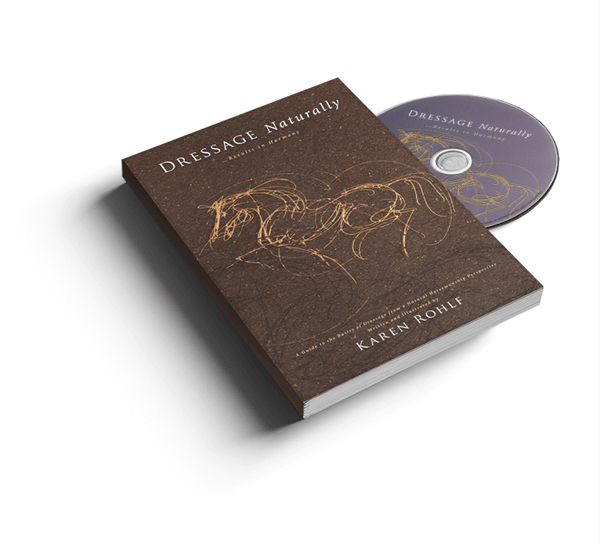 Karen Rohlf's Book/DVD: Dressage Naturally... Results In Harmony
Karen Rohlf's Book/DVD: Dressage Naturally... Results In Harmony
gives you a fresh look at dressage and empowers you to progress.
Includes theory, exercises and 3 hours of DVD.
Stepping Over Dollars To Pick Up Pennies
When you don't know the real purpose of an exercise you can end up prioritizing the wrong things. I often see riders correcting an ultimately desirable behavior in order to perfect something that is not as important.
These are what I call Mistakes In The Right Direction. Many riders who don't think of the big picture handle these in a less than beneficial way.
A rider who has been practicing serpentines well may experience a moment of greater suppleness on a formerly stiff horse. He may feel a bit wiggly. This sometimes causes a stage of less accuracy in the horse's line of direction. A rider may over-correct this, misinterpreting it as a lack of attention or disobedience rather than due to a more loose and supple body they aren't used to riding.
If the rider punishes or over-corrects the looseness instead of adapting their riding, they could cause the horse to brace and stiffen which would cancel out the true benefit of the serpentine exercises they have so diligently been doing!
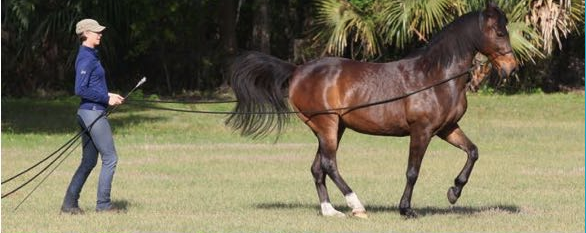
You can do a million transitions and they could put your horse on the forehand OR you could do them with the intention of developing greater carrying power and engagement. If you have the benefit in mind, you will be able to tell when your horse improves.
For example, if your horse suddenly lifts and carries better into a canter depart, you will be mindful enough to praise that effort even if he picked up the wrong lead in that moment. If you have only a competition mind-set, you might over-correct and shut down the real benefit. You will know he tried and will reward his effort toward the qualities you were aiming for. The little messes will be easier to clean up later.
Understand. Feel. Grow.
When you ride based on benefits and intentions, a world of training possibilities open up for you. You will have better awareness of what types of exercises there are and what qualities they develop in your horse. You will see the cause and effect of your training plans. You will be able to become more strategic in choosing what exercises to do.
A guideline:
-
Understand the categories of exercises and what they aim to develop.
-
Understand particular exercises in order to know whether they are appropriate for your horse and your immediate training goals.
-
Learn the Criteria (the roadmap) of an exercise
-
Once you are actually doing the exercise, then remember WHY you are doing it! Know the Essence and the benefit.
-
Always know what success looks like so you can reward your horse at the right time for the right thing!
- ASK QUESTIONS! Your instructor should be there to help you. Let them know when you are experiencing confusion or lack of clarity.
When you train yourself to think this way, you can create your own patterns and exercises. Often, through creativity and experimentation (or just dumb luck) I stumble across a pattern that gets a great result with a particular horse.
Dressage is a science, and it is also an art. Remember to think AND feel!
You and your horse will both enjoy learning dressage more when you are able to feel the benefit of it!
Thoughts? Scroll down to leave a comment below.


